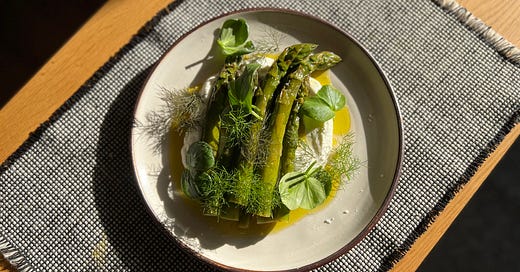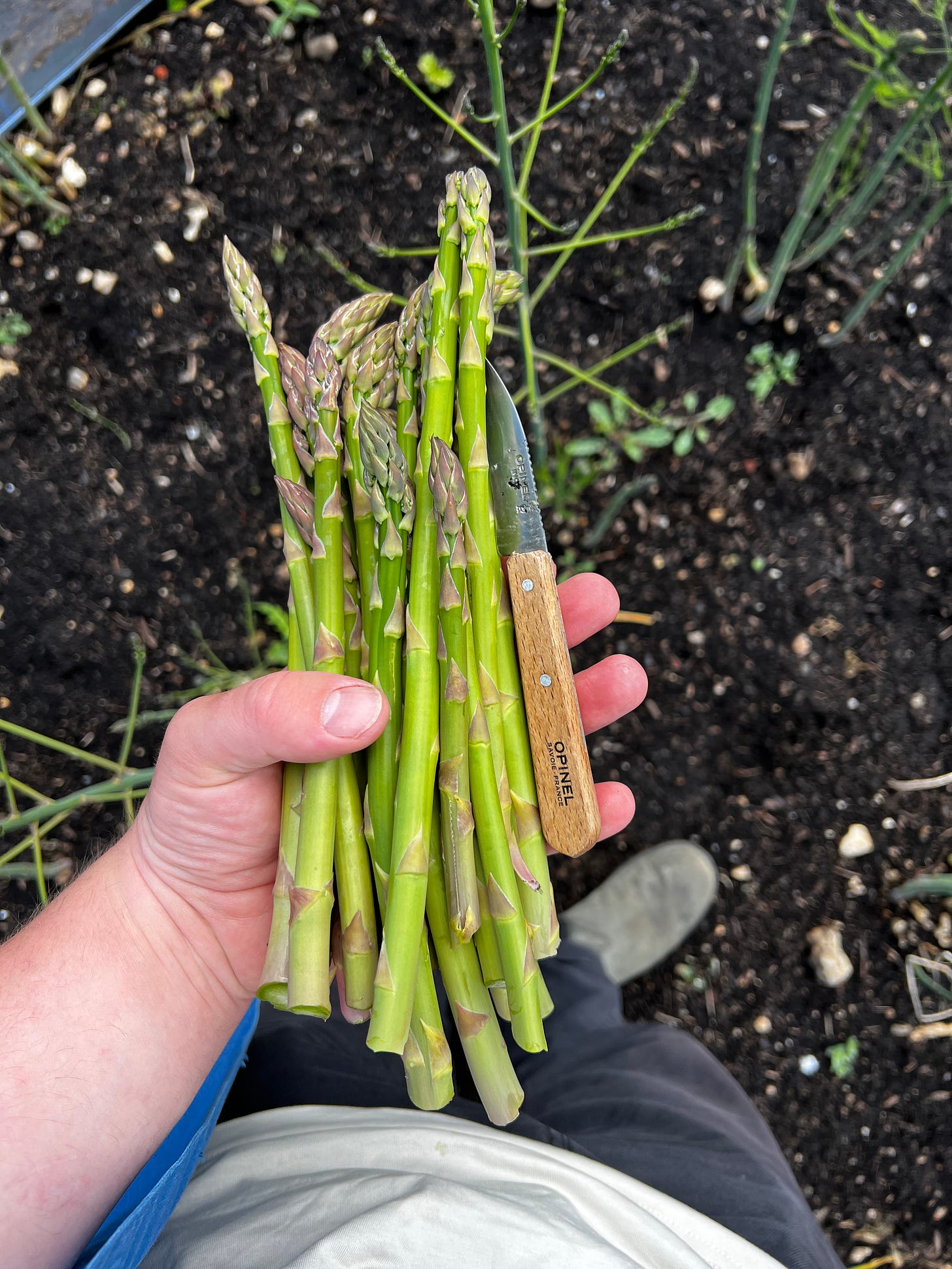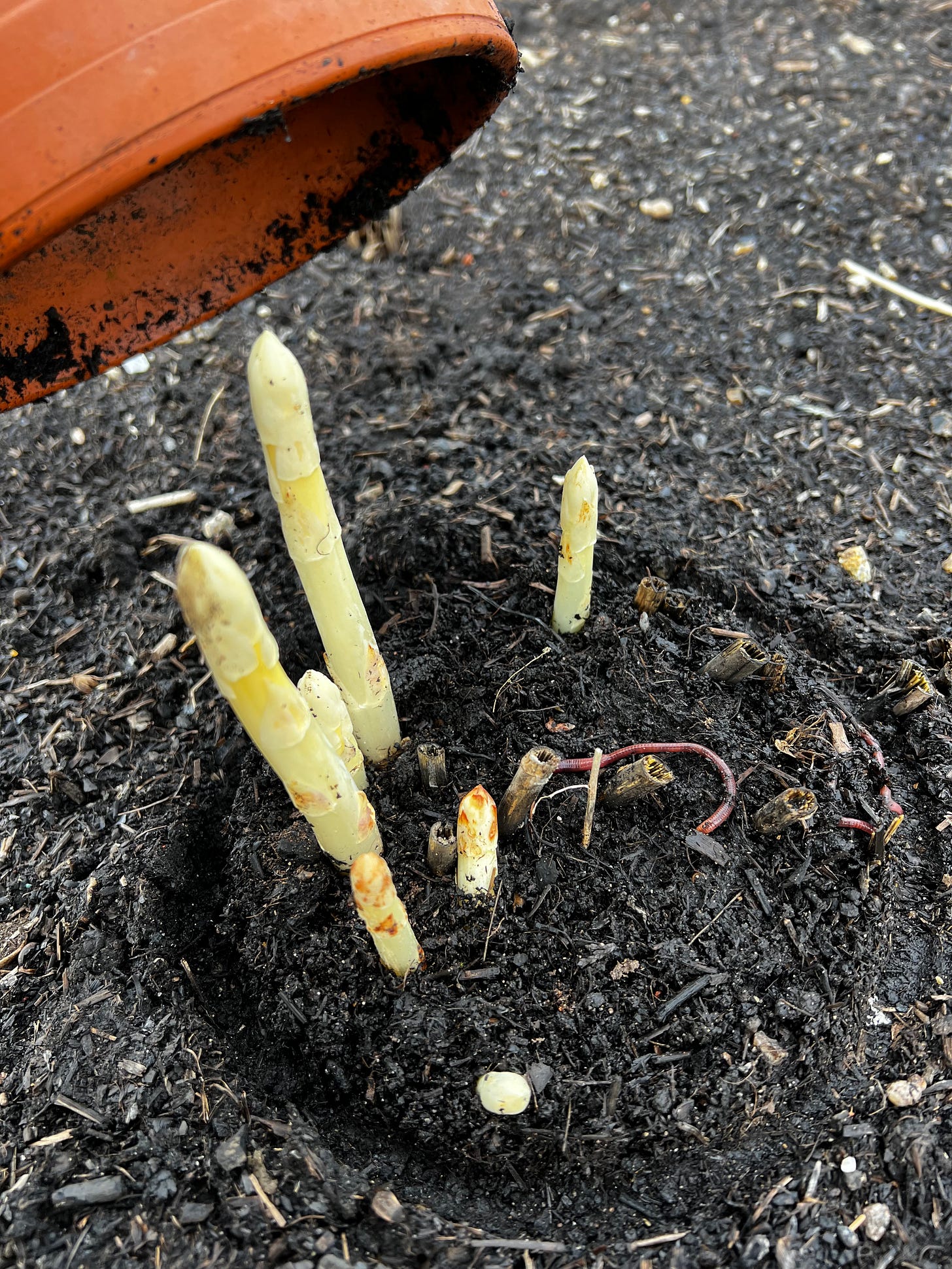Roman-style asparagus, goat's curd and herbs
A failsafe method for cooking it for those that like to keep things simple. A little on facts and folklore, too.
There is no actor more suitable than asparagus for the title role in all of spring’s many turbulent genres. Spears stand to attention in waiting for an iron grill and glowing coals should the opening weeks be golden, hazy and dry. They can provide much comfort, too, when cooked with eggs and warm muffins in the more likely event that the skies are grey and drizzly. Flaky galettes, bubbling soups, buttery pastas and simple salads abound; whatever the weather in late April and early May, asparagus is the most likely candidate for the table.
All flora have their secrets, and asparagus is no different. When a window for gorging on something is as fleeting as it is for bunches of the vivid green (and at times purple and even white) spears I mention here, a cook is best placed to arm themselves with a wealth of facts and folklore alike. All that’s left then is to dive into the kitchen and soak-up all of it’s short-lived glory.
Some of my favourite things to recall when in the kitchen with asparagus;
Spears must be cut or snapped with care, so as to waste as little as possible of nature’s first green gift of the growing season.
It’s worth noting that, especially if using your asparagus for dipping in a mayonnaise or vinaigrette, the woody ends needn’t be removed. As Fergus Henderson famously explained, they act as perfect and stable handle provided in kind by nature itself.
Longer stems may be older, or have been cut from under the earth, rather than above it and require a little peeling at the base of their snapped limbs. A swivel peeler is an excellent tool for the job and even removing the bottom 2-3cm can be enough to rid the unwanted bite and fibrous character of an unruly spear. If you aren’t sure whether to peel your spears or not, simply take a small bite from the base of one. If it’s at all tough or stringy, peeling is advised. Peelings should kept (see below)!
Any discarded woody stems can be kept and dropped into bubbling pots of stock or broth for an addition of spring-like earthiness, or used in the base of a soup when other vegetables are sweating and softening.
Few items are more useful in a kitchen than the elastic band that clutches a bunch of asparagus together. I collect them as a matter of urgency.
Asparagus should never be served at a spring wedding or large gathering of friends, should the bathrooms become too pungent and distract from the merriment and bliss of love and wine.
Once harvested (or more often procured), store a bunch in a small glass of water in your fridge, with spears facing upward and the cut ends of each spear submerged just a centimetre or two.
The starting pistol for harvesting asparagus in England is meant to fall on St George’s Day (23rd April), but spears grown in polytunnels often appear much earlier. It thrives in temperatures above 6-10c and bolts at much above 20c, producing thinner and more elongated stems and leaves in a rush to go to seed. With this in mind, depending on the climate of the spring at hand, spears can be worthy of the table well into early June.
Asparagus is a claw-shaped perennial crown, sending out shoots (much like any plant in the adolescent stages of a growing season) which grow into a beautiful fernlike plant that produces berries (shown in the video below). These shoots are our main order of business, harvested as the plant wakes from winter. A light and sandy soil ensures an easy path to the surface, and is why the main crop of asparagus in England lands from the likes of Norfolk, Suffolk and Herefordshire.
I must admit that my favourite way to enjoy asparagus is blanched in boiling salted water, served with far too much butter, a little lemon or spritz of vinegar and a generous grating of Spenwood or Corra Linn. I thought that would possibly make for a rather short and boring newsletter and so, while trying to hold tight to the simplicity of dropping spears into a pot, my mind was thrown back to eight years ago, when I was staging at The River Cafe.
A stage is a period of unpaid work in a kitchen, common among professional cooks who’re keen to get to the heart of a particular chef or restaurant’s cooking. Back in 2017 and having worked for Jamie Oliver for just shy of two years, The River Cafe had been mentioned to me a great many times. I wrote to one of the Chef’s, Joe Trivelli, and shortly after found myself in the midst of two weeks cooking that would shift my perspective on food, for better and for worse (more on this in a future newsletter).
Not only were the chefs at The River Cafe entirely impressive but they were wonderful educators, too. After preparing eight crates of violet artichokes, I soon forgot the many small cuts on my hand as I was so keen to make room in my mind for the method of cooking that was being explained to me.
Always wear gloves when embarking on any artichoke-related task - midway through artichoke prep I dabbled in the chopping of a soffritto for a pan of risotto one of the chef’s was making. Some hours later during service and when tasting the dish at the pass, Joe jarringly looked up from the pan and straight at me. With one mouthful and amidst great quantities of rice, dairy and Barolo he had tasted the bitterness of my morning’s endeavour. “Did you help with this risotto?” he asked me. “Without gloves on your hands are passing bitterness to every ingredient you touch.” It has always stuck with me.
Artichokes cooked in the Roman style (alla Romana) are prepared removing tough outer leaves and any inner choke and are then often laced with herbs and garlic and placed upside down in a heavy-bottomed pan. Next comes the detail that we’ll borrow for our asparagus in the recipe below. Water, olive oil and white wine (sometimes) are added each in equal quantities - the water evaporates and renders the artichokes tender, the wine evaporates and flavours them and what remains is a glorious infusion of fragrant oil that sizzles and turns the bottom of the artichokes golden.
Roman-style asparagus with goat’s curd and herbs
Serves 2, as a starter
This simple recipe creates a wonderful starting point that you can take in any direction you wish. As long as the quantities in the pan remain the same, swaps can happily be made. Omit the vermouth for wine, or use something sharper like vinegar or verjus. Herbs are a very welcome addition, as are the likes of dried chilli flakes, black pepper, walnuts, fennel seeds, mustard or shallots. Whatever you choose to add, it’s important to retain the cooking liquor. A vegetable leaves much in the pot when cooked and this recipe captures every glorious ounce of it, ready for you to administer spooned over the cooked spears.
250g thick asparagus spears (about 8)
50ml extra virgin olive oil
50ml dry white vermouth or wine
2 cloves of garlic
1 lemon
125g goat’s curd, or mozzarella
Broad bean shoots and fennel fronds, to serve
Carefully remove the woodiest ends of the asparagus with a knife and keep for another use, peeling the very bottoms of the spears if they’re at all tough and/or fibrous. Add to a heavy-bottomed frying pan that holds them all flat but snug. Add a generous pinch of salt, followed by the olive oil, vermouth and 50ml cool water.
Peel and finely slice the garlic and add this to the pan, along with a few strips of lemon peel, avoiding the bitter white pith if possible. Shimmy the pan slightly to ensure all components are in contact with the liquid in the pan. This will ensure even cooking.
Place the pan over a high heat and watch and listen carefully - the line between cooked and overcooked is a mighty thin one here. The water will begin to plume in large bubbles, the evaporation sounding soft and rounded. As the wine and water reduce the bubbles will, too. The sound of cooking will sharpen and crackle, sounding harsher and more akin to frying as the majority of what remains in the pan is oil. Remove from the heat and serve immediately. This should take roughly 3 and a half minutes.
Spoon goat’s curd or break mozzarella onto plates. Season with salt and freshly ground black pepper. Divide the asparagus evenly over both plates and cover in much of the remaining cooking liquid. Finish by scattering over torn herbs - I love using broad bean tips and fennel at this time of year.
-
Welcome to Salt and the Earth, a newsletter full of recipes and writing to help you feel a deeper connection to the food you eat, every time you cook. Each entry should arm you with the knowledge and confidence to know what’s growing right now, and exactly what to do with it.
Thanks so much for being here. If you’ve arrived by accident, or on the generous recommendation of a friend - you’re most welcome. Subscribe below (it’s free!) and never miss a newsletter.
Hugo x









Sounds delicious.
I'm so happy with butter and lemon too.
*Deli